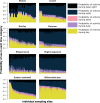Mammals adjust diel activity across gradients of urbanization
- PMID: 35357308
- PMCID: PMC8986314
- DOI: 10.7554/eLife.74756
Mammals adjust diel activity across gradients of urbanization
Abstract
Time is a fundamental component of ecological processes. How animal behavior changes over time has been explored through well-known ecological theories like niche partitioning and predator-prey dynamics. Yet, changes in animal behavior within the shorter 24-hr light-dark cycle have largely gone unstudied. Understanding if an animal can adjust their temporal activity to mitigate or adapt to environmental change has become a recent topic of discussion and is important for effective wildlife management and conservation. While spatial habitat is a fundamental consideration in wildlife management and conservation, temporal habitat is often ignored. We formulated a temporal resource selection model to quantify the diel behavior of 8 mammal species across 10 US cities. We found high variability in diel activity patterns within and among species and species-specific correlations between diel activity and human population density, impervious land cover, available greenspace, vegetation cover, and mean daily temperature. We also found that some species may modulate temporal behaviors to manage both natural and anthropogenic risks. Our results highlight the complexity with which temporal activity patterns interact with local environmental characteristics, and suggest that urban mammals may use time along the 24-hr cycle to reduce risk, adapt, and therefore persist, and in some cases thrive, in human-dominated ecosystems.
Keywords: ecology; mammal; temporal resource selection; urban; wildlife cameras.
Conflict of interest statement
TG, MF, BG, AA, JA, MA, AC, DD, DG, EL, MM, TR, CS, CS, HS, TS, JW, JB, KS, SM No competing interests declared
Figures





References
-
- Chamberlain S. rnoaa: “NOAA” Weather Data from R. R Package Version 0.9.6 2020
-
- Clinchy M, Zanette LY, Roberts D, Suraci JP, Buesching CD, Newman C, Macdonald DW. Fear of the human “super predator” far exceeds the fear of large carnivores in a model mesocarnivore. Behavioral Ecology. 2016;27:arw117. doi: 10.1093/beheco/arw117. - DOI
-
- Cove MV, Kays R, Bontrager H, Bresnan C, Lasky M, Frerichs T, Klann R, Lee TE, Crockett SC, Crupi AP, Weiss KCB, Rowe H, Sprague T, Schipper J, Tellez C, Lepczyk CA, Fantle-Lepczyk JE, LaPoint S, Williamson J, Fisher-Reid MC, King SM, Bebko AJ, Chrysafis P, Jensen AJ, Jachowski DS, Sands J, MacCombie KA, Herrera DJ, van der Merwe M, Knowles TW, Horan RV, Rentz MS, Brandt LSE, Nagy C, Barton BT, Thompson WC, Maher SP, Darracq AK, Hess G, Parsons AW, Wells B, Roemer GW, Hernandez CJ, Gompper ME, Webb SL, Vanek JP, Lafferty DJR, Bergquist AM, Hubbard T, Forrester T, Clark D, Cincotta C, Favreau J, Facka AN, Halbur M, Hammerich S, Gray M, Rega-Brodsky CC, Durbin C, Flaherty EA, Brooke JM, Coster SS, Lathrop RG, Russell K, Bogan DA, Cliché R, Shamon H, Hawkins MTR, Marks SB, Lonsinger RC, O’Mara MT, Compton JA, Fowler M, Barthelmess EL, Andy KE, Belant JL, Beyer DE, Kautz TM, Scognamillo DG, Schalk CM, Leslie MS, Nasrallah SL, Ellison CN, Ruthven C, Fritts S, Tleimat J, Gay M, Whittier CA, Neiswenter SA, Pelletier R, DeGregorio BA, Kuprewicz EK, Davis ML, Dykstra A, Mason DS, Baruzzi C, Lashley MA, Risch DR, Price MR, Allen ML, Whipple LS, Sperry JH, Hagen RH, Mortelliti A, Evans BE, Studds CE, Sirén APK, Kilborn J, Sutherland C, Warren P, Fuller T, Harris NC, Carter NH, Trout E, Zimova M, Giery ST, Iannarilli F, Higdon SD, Revord RS, Hansen CP, Millspaugh JJ, Zorn A, Benson JF, Wehr NH, Solberg JN, Gerber BD, Burr JC, Sevin J, Green AM, Şekercioğlu ÇH, Pendergast M, Barnick KA, Edelman AJ, Wasdin JR, Romero A, O’Neill BJ, Schmitz N, Alston JM, Kuhn KM, Lesmeister DB, Linnell MA, Appel CL, Rota C, Stenglein JL, Anhalt-Depies C, Nelson C, Long RA, Jo Jaspers K, Remine KR, Jordan MJ, Davis D, Hernández-Yáñez H, Zhao JY, McShea WJ. SNAPSHOT USA 2019: a coordinated national camera trap survey of the United States. Ecology. 2021;102:e03353. doi: 10.1002/ecy.3353. - DOI - PubMed
Publication types
MeSH terms
Associated data
LinkOut - more resources
Full Text Sources

